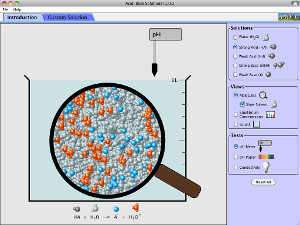The formula for an acid has hydrogen as its positive part, such as hydrochloric acid, HCl (H+ and Cl–).
An acid indicator is a chemical that changes color when added to an acid. If the indicator is dry, such as litmus paper, the paper changes color when an acid solution touches the paper.
Facts: The video provides details about acids. Click around and discover the difference between weak and strong acids and how they affect acid indicators, including litmus.
Part I: Litmus Paper: Test for An Acid
Purpose: To identify a positive test for an acid using litmus paper.
Materials
1 strip of red litmus cut in half
1 strip of blue litmus cut in half
white index card
eyedropper (or stirring rod, craft stick, plastic knife)
1 teaspoon white vinegar
Procedure:
Determine the positive test for an acid using litmus using each of the following procedures.
1. Hold one end of one of the red litmus strip, then touch the opposite end of the strip in the vinegar. Repeat using one of the blue litmus strip. Discard these strips.
2. Lay the remaining red and blue litmus strips on the index card. Fill the eye dropper with vinegar, then place one drop of vinegar on the end of each of the litmus strips.
3. Stir the vinegar with a stirring rod, wooden craft stick, or plastic knife, then touch the wet end to dry end of each litmus strip on the index card.
Results: Each procedure produces the same results, the blue litmus turns red and the red litmus get wet.
Conclusion: Blue litmus can be used to identify an acid. Blue litmus turns red when it touches an acid solution.
Part II: Identifying an Acid with Blue Litmus
Purpose: To identify acids using litmus paper.
Procedure:
1. Testing Liquids for the Presence of an Acid
Use one of the testing procedures in Part I, replacing vinegar with other liquids, such as lemon juice, orange juice, etc…
2. Testing Solids for the Presence of an Acid
To test a solid, first crush the solid so that it can be dissolved in distilled water. For example, test a Vitamin-C tablet by crushing it with a rolling pin on a cutting board. Add 3 or 4 drops of distilled water to the powder. Stir to mix the water and aspirin powder. You do not have to dissolve all the powder. Then touch the liquid with a piece of blue litmus. When blue litmus turns red, it is a positive test for the presence of an acid.
Solid to test: detergent, baking soda, baking powder and cream of tartar.
